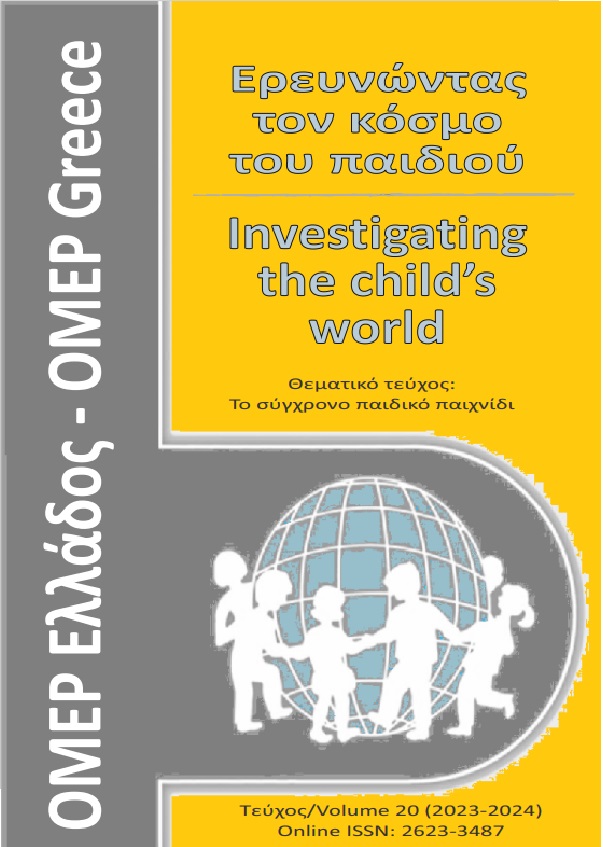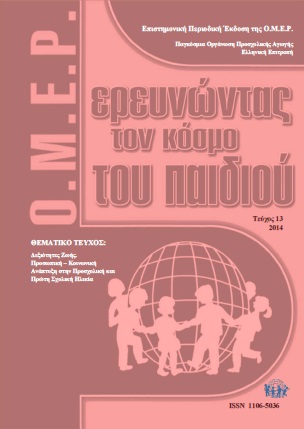Η απόλαυση του κειμένου: παιχνίδια με το κείμενο και την εικόνα στο μεταμυθοπλαστικό εικονογραφημένο βιβλίο
Abstract
Το παιδικό βιβλίο σήμερα έχει πολλές και διαφορετικές μορφές, ακολουθώντας τις κοινωνικές και πολιτισμικές αλλαγές γύρω του. Τα τελευταία χρόνια παρατηρείται μία αύξηση εικονογραφημένων βιβλίων με ιδιαίτερα, καινοτόμα χαρακτηριστικά. Κάποια από αυτά έχουν ψηφιακά χαρακτηριστικά και συνδέονται με την τηλεόραση και την κοινωνία της πληροφορίας. Άλλα παρωδούν προηγούμενα έργα, και άλλα θεωρούν την πραγματικότητα ως μια κουλτούρα από ανακυκλωμένες εικόνες. Τα εικονογραφημένα μεταμυθοπλαστικά κείμενα μπορεί να είναι αυτοαναφορικά δηλαδή να αναφέρονται στο ίδιο το κείμενο ως κατασκευή, ή και αυτοσυνειδητά οι χαρακτήρες του βιβλίου να αποκτούν συνείδηση της ύπαρξής τους ως μυθιστορηματικά πρόσωπα και να συνδιαλέγονται με τους αναγνώστες τους. Έχουν έναν υπαινικτικά παρωδιακό τόνο και στόχος τους είναι να υπερβούν τα όρια ανάμεσα στη φαντασία και την πραγματικότητα. Οι συγγραφείς και εικονογράφοι χρησιμοποιούν τεχνικές, όπως η μετάληψη και η διακειμενικότητα, εκμεταλλεύονται την υλικότητα του βιβλίου και χρησιμοποιούν το design με τέτοιους τρόπους που βάζουν τον αναγνώστη στη θέση του παίκτη και μετατρέπουν την ανάγνωση σε λογοτεχνικό παιχνίδι που εξερευνά τους κανόνες της αφήγησης.
Article Details
- Zitationsvorschlag
-
Πασχαλίδου Ε. (2024). Η απόλαυση του κειμένου: παιχνίδια με το κείμενο και την εικόνα στο μεταμυθοπλαστικό εικονογραφημένο βιβλίο. Ερευνώντας τον κόσμο του παιδιού, 20, 119–127. https://doi.org/10.12681/icw.37036
- Rubrik
- Επιστημονική αρθρογραφία & εκπαιδευτικές δράσεις

Dieses Werk steht unter der Lizenz Creative Commons Namensnennung - Nicht-kommerziell 4.0 International.
Οι Συγγραφείς που δημοσιεύουν εργασίες τους σε αυτό το περιοδικό συμφωνούν στους παρακάτω όρους:
Οι Συγγραφείς διατηρούν τα Πνευματικά Δικαιώματα και χορηγούν στο περιοδικό το δικαίωμα της πρώτης δημοσίευσης ενώ ταυτόχρονα τα πνευματικά δικαιώματα της εργασίας προστατεύονται σύμφωνα με την Creative Commons Attribution License που επιτρέπει σε τρίτους - αποδέκτες της άδειας να χρησιμοποιούν την εργασία όπως θέλουν με την προϋπόθεση της διατήρησης των διατυπώσεων που προβλέπονται στην άδεια σχετικά με την αναφορά στον αρχικό δημιουργό και την αρχική δημοσίευση σε αυτό το περιοδικό.
Οι Συγγραφείς μπορούν να συνάπτουν ξεχωριστές, και πρόσθετες συμβάσεις και συμφωνίες για την μη αποκλειστική διανομή της εργασίας όπως δημοσιεύτηκε στο περιοδικό αυτό (π.χ. κατάθεση σε ένα ακαδημαϊκό καταθετήριο ή δημοσίευση σε ένα βιβλίο), με την προϋπόθεση της αναγνώρισης και την αναφοράς της πρώτης δημοσίευσης σε αυτό το περιοδικό.
Το περιοδικό επιτρέπει και ενθαρρύνει τους Συγγραφείς να καταθέτουν τις εργασίες τους μέσω διαδικτύου (π.χ. σε ένα ακαδημαϊκό καταθετήριο ή στους προσωπικές τους ιστοσελίδες) πριν και μετά από τις διαδικασίες της δημοσίευσης, καθώς αυτό μπορεί να οδηγήσει σε παραγωγική ανταλλαγή ιδεών και σκέψεων καθώς επίσης και σε γρηγορότερη και μεγαλύτερη χρήση και ευρετηρίαση της δημοσιευμένης εργασίας (See The Effect of Open Access).




